When the short-term gets hazy, remember the big picture.
The drop so far (about 6% in 12 days on a closing basis, 9% in 13 days intraday):
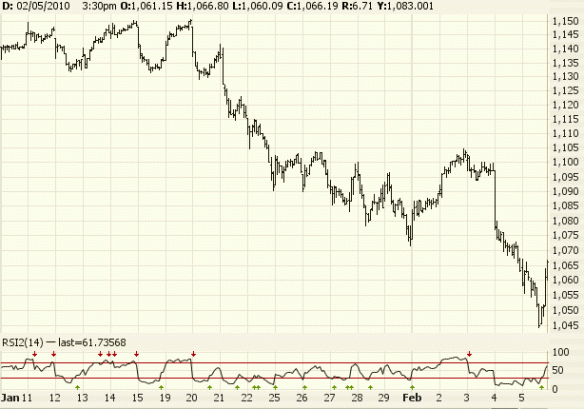
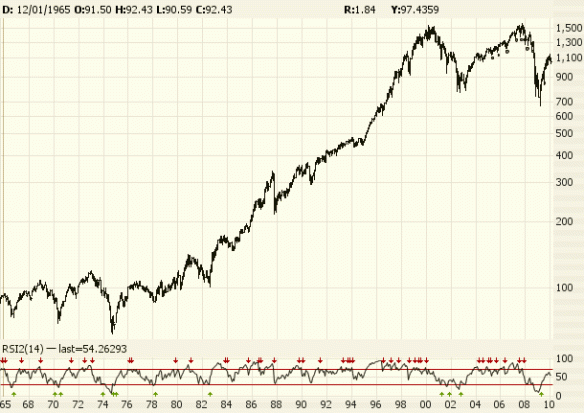
Source: Prophet.net
Here are the conditions I am watching: RSI on the daily scale is now oversold. However, DSI bullishness has dropped from near 90% to the 30s, which still leaves a little room on the downside for a first wave down from a big bull move (these sell-offs often end with about 20% bulls). Put:call is still very low for the bottom of a sell-off of this intensity. The VIX also has room to run, since it has still not cracked 30.
The deeply oversold hourly RSI, the swiftness Friday afternoon’s 2% snap, and the daily reversal bar (new low, then a close above the previous close) suggest that a countertrend rally has just kicked off, but if that is the case, it is from somewhat more subdued conditions than often mark the end of sell-offs of this type (a sudden drop after a long, smooth trend upward on great complacency). If this were 2009, the market would respect the current oversold condition, hold and then rally, but the Great Bounce is over, and the character of the market has changed. Although it feels like we’ve already filled our panic quota, the put:call ratio, VIX and DSI leave open the possibility of a very sharp (3-6%) intraday drop early this week from which the market would recover quickly and rally for several days or weeks.
Another possibility, and I somewhat favor this one, is that the rally from Friday’s lows is meaningful, but will not retrace as much of the decline as rallies from bottoms with more signs of panic. In this case, I’d be looking for a top no higher than 1100 on the S&P.
This is a tricky juncture to trade, since there is no near-term expectation of anything but volatility. I would not want to be levered short nor long here. A trader could go long against Friday’s lows for a quick trade, or stay short while ready to absorb a 5% or even 10% rally. Traders with modest, unlevered short positions (not inverse ETFs) can relax and just check the market each evening and not worry about the chop or even a big retracement. The real money is made in the sitting, as Livermore said. 50 points is not worth getting shaken out of 500.
Deflation has been here all along; the markets just pretended otherwise.
I sure wish I’d sat tight on all of my (levered) shorts from January: stocks, sugar, cocoa, oil, copper, platinum, palladium, silver, euro, Swiss franc, New Zealand dollar, South African Rand. ALL of these have fallen heavily. I captured 1/4 – 3/4 of their respective drops, so it has been a great three weeks, but I would have been served so much better by just letting everything run than attempting to finesse positions. This across the board selling, with strength in the dollar, yen and Treasury bonds is the same old deflation trade that pummelled everyone but shorts in 2008.
I view 2008 as a warm-up, a down payment on what is coming in 2010 and beyond. The recovery of 2009 is a fraud, and it will be seen clearly as such a year from now. Obama, Bernanke and Geithner will be thrown to the wolves, and politics will start to get more interesting, with all kinds of radical ideas gaining traction with the public, few of them sensible.
To help prop up the government another war could be started, since the neocons (who never left power but just use a “D” puppet now) would like to destroy more of the middle east. Ugly, ugly stuff, but all too familiar… how does that song go, “all my life, panic in America”?
Ok, let’s look at some charts:
Here is the 5-day average equity put:call ratio. I’m still looking at the summer 2007 period for clues. Remember the flickers of early panic that August, like Cramer’s tantrum? (By the way, my money says that was staged to get public support for inflationary Fed actions at a time when everyone was worried about inflation.)
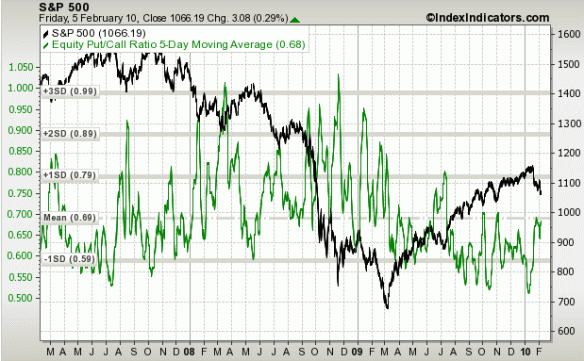
Indexindicators.com
You can see that we’ve still only reached the mean on this powerful fear gauge. It sure feels like panic out there, but only becuase of how serene things have been lately, just like in spring 2007, the Goldilocks era.
Here’s a daily chart of the last 8 months (I’m also eyeing last summer’s dip for hints, since it was a deflation scare and major sell-off that may offer clues as to some of the dynamics at play):
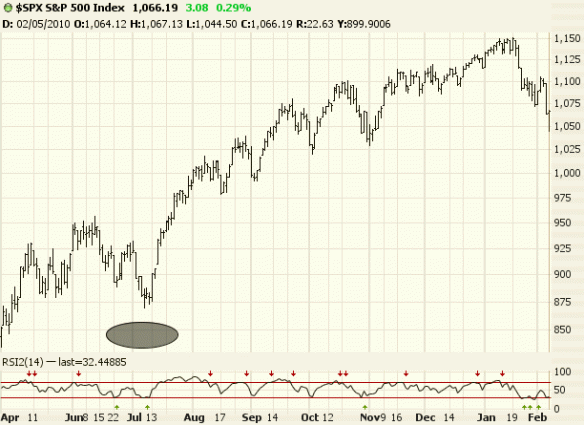
Prophet.net
–
Here are some more snapshots of tops, starting with the 2007-2008 b-wave top (the a-wave was 2000-2003, and c is underway — this is Prechter’s labeling, which considers 2000 the start of the bear):
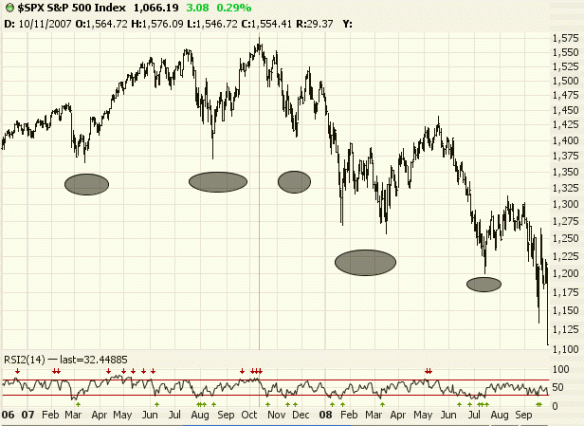
–
If this move is like the initial drops at the b-wave top, it is mostly over and will be followed by a rally that retraces most if not all of the way back up. There is a difference, though — that was a cycle wave top, and while market complacency has been extreme lately, social mood is nothing like 2007, and the economy is in the toilet. This is the most overvalued market in history (including ’99-’00), and more importantly, it has already taken a wrecking ball to the 2002-2005 technical support. As we saw in the spring of 1930, third waves can move very swiftly through the territory of second waves. Actually, this whole cycle wave c is a third wave on a larger scale, and it only took 12 months to retrace the entire 4.5 year rally from spring 2003. The start of a smaller scale 3rd wave can been seen above in the decline from the May 2008 peak: unrelenting. (Much of this labeling of higher degree waves has emerged as a kind of consensus among wavers, including Prechter’s EWI, Mish, Daneric and Mole.)
Here is the top of the bear market rally that lasted from Nov 1929 – April 1930:
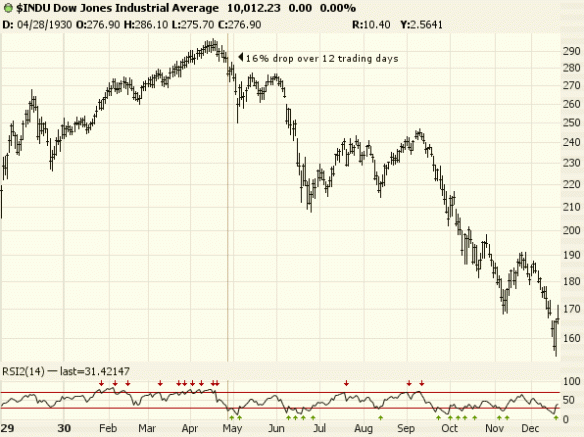
–
That drop started off with more intensity than this one, as the Dow has fallen just 8.3% intraday in 13 trading days, compared to 16% in 12 days. It is of course possible that we catch up very quickly with a minor crash, akin to the gap down and 6.4% intraday drop on May 5th 1930. Prior to that the market was down 11% intraday. Note how the market crashed from allready oversold conditions, as it usually does. Such a washout also happened on August 16, 2007. A 5% intraday loss this Monday or Tuesday would be one way to resolve the still mild VIX, put:call and DSI readings. If such a crash does occur, it would be a good time to buy in anticipation of a very sharp snap-back. It is probably too early for a sustained crash (Oct ’29, Oct ’87, Oct ’08), but of course in ’87 the market went from oversold to very oversold to the greatest intraday drop of all time. It did not, however, do that right from the top without putting in a first and second wave:
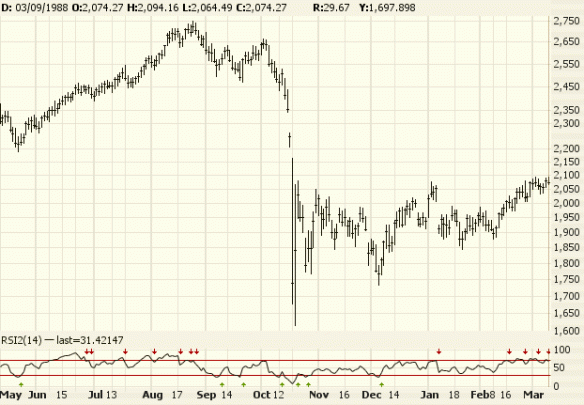
–
Now that’s why you need stop-losses (and another reason why futures are best since you get stopped out overnight and not at the open by which time the market could be down 8%).
One more big top for your consideration, 1937: the first wave down was composed of a series of ones and twos — 5% declines, 3% gains, rinsed and repeated:
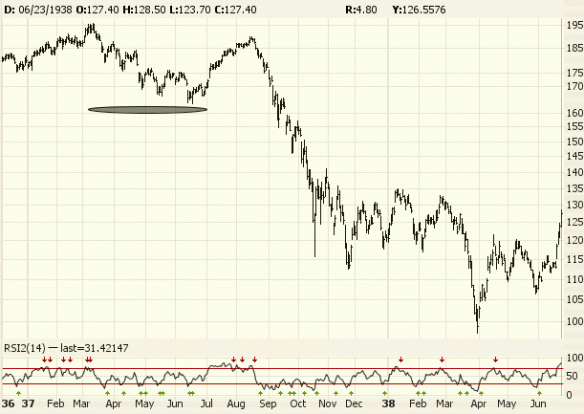
–
(That’s right, the market crashed again after FDR’s policies hamstrung the economy and pushed the US deeper into the depresssion. The market fell lower still in 1942 as the war and inflation crushed private enterprise.)
I’m also keeping an eye on the finacials and REITs, which would both look better if they dropped a bit more before a bounce. There just isn’t that much so far to react against. The financials (XLF):
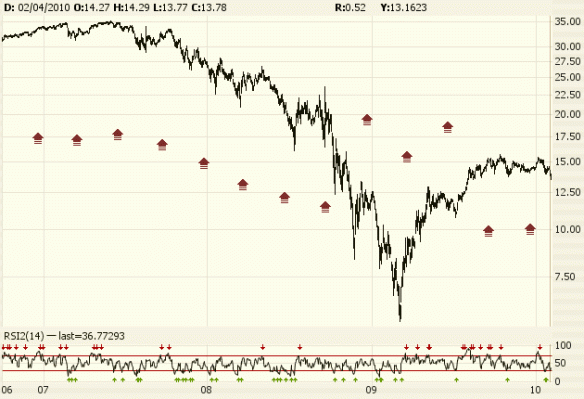
–
The REITs (IYR):
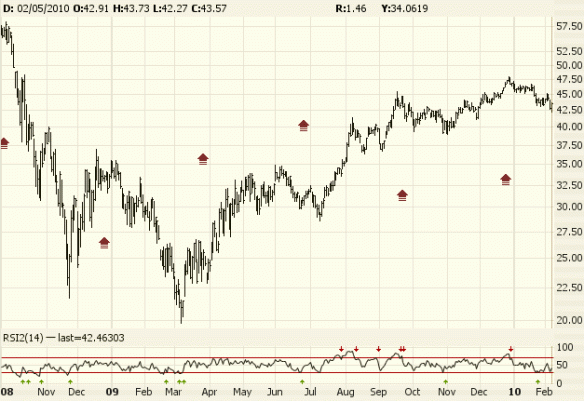
–
I don’t see much panic at all in these groups, though they are clearly rolling over. They could stall for a while, but It is hard to see a big bounce here, and without the financial sector the rest of the market isn’t going to get far.
In sum, my best guess is that this will play out like either (1) July-August 2007: chop for the next week or two — big swings, maybe a new low — then some kind of rally for 2-6 weeks (though I don’t think we’ll get a new high — my target would be 1075-1115); or (2) May-June 2008, with a steady drift down. But for 2010, it’s just down, down, down.





















